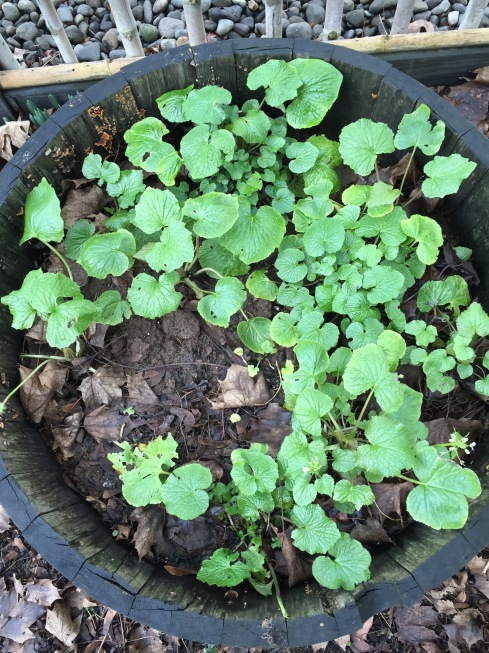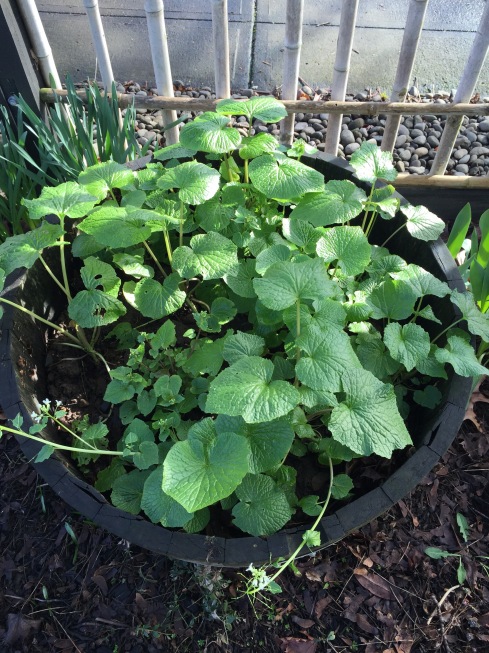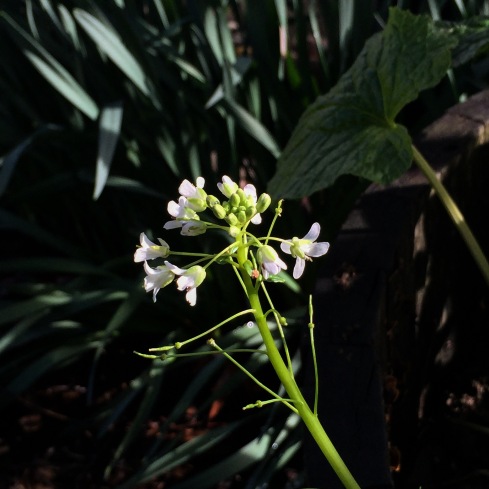The leaves, stems and flowers of garden-grown wasabi plants are perfectly edible. Wasabi is a brassica. So, like kale, the leaves and stems on the side can be removed / snipped off and eaten while the plant will grow from the top (apical meristem). The examples shown on this page were grown in the Willamette Valley in Oregon (Plant Hardiness Zone 8a.), not on the Oregon Coast where the Frog Eyes Wasabi Farm is located. We wanted to approximate a laissez faire gardener environment, with no special treatment, hot and dry conditions in the summer and cold in the winter (relative to the Oregon Coast) to test the plants’ response. They were planted in September, 2014 and the foliage shown is in March 2015. They were grown in well-drained soil with approximately 20% gravel and the remainder soil and compost. A bit of 14-14-14 lawn fertilizer was applied once per year. They endured an ice storm in November 2014 and snow in December 2015.
Below is a photo chronicle of these garden wasabi following the Dec. 2015 snow. (Note, this is a Pacific Northwest snowstorm. The likes of which much of the rest of the country would hardly take note. The temperature was only ~30dF/-1dC and the snow was only a dusting.). I’m showing this as a reference to those that want to know if the wasabi plant can survive a freeze.

Here are the same plants one month later on Jan. 30 2015. Observe the new growth in the small leaves in the lower canopy. Also observe the vacant space that one plant died last summer during the PNW drought. (I did replace this plant in later photos.) Also observe the first flowers in the lower-right corner. These plants begin their flowering cycle on Winter Solstice and then flowers are often visible by about February and may last until April / June depending on conditions. The leaves and stems are perfectly edible at this stage (any stage really). As long as the apical meristem is left intact. See below for a photo of the meristem growth.

Feb. 2 2015: This photo shows the plants just a few days later on Feb. 2. Note, I’ve planted a plant start from Frog Eyes Wasabi Farm in the vacant location. Note how much the plant has grown in the next photo. 
Feb. 20 2015. What growth! Observe the height of the leaves above the barrel rim that were below just 18 days ago. Also, note the height of the two flowers and the leaf diameter. Lastly, note the leaf coverage in multiple canopy layers with the largest leaves on top and the medium and then smaller leaves below. These will all progress to form a full canopy with approximately 6-inch diameter leaves by April/May. See previous posts for photos of these very same plants from past years. This is an important point; some of these plants are the same originally planted in September 2014. Though we did lose a few in last summer’s heat and our intentional neglect. See this post for more information.

Feb. 20 2015 continued: Wasabi flowers are rare indeed. The plants drop their leaves on winter solstice and commence their flowering cycle which ends in mid April (but can continue through June). This specimen grown in a typically shady spot in Portland Oregon in standard-issue garden soil and conditions. The flowers are edible traditionally tempura-fried or steeped into a tea.

Feb. 20 2015: My finger pointing at the apical meristem growth. That is the top of the plant. This is the most important part of wasabi growth. If the plant start has this, it’ll continue growing. The side stems senesce as the plant grows vertically and if really happy, producing a wasabi rhizome underneath!
